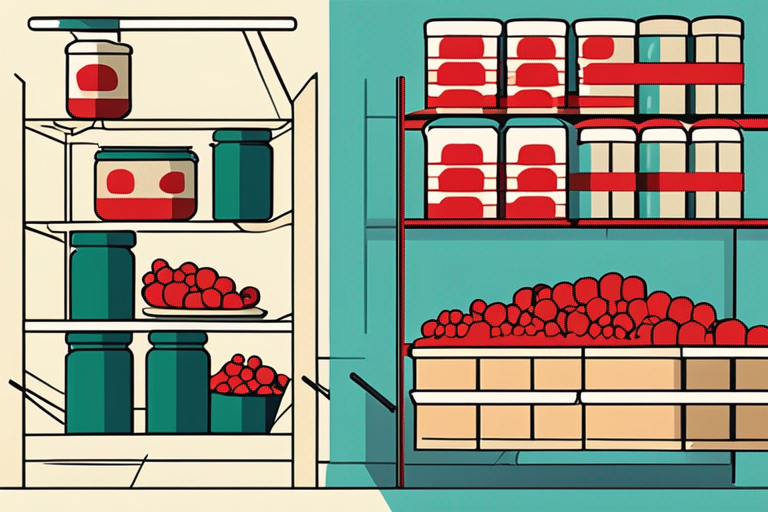
Proper Storage of Buffalo Currant to Extend Its Shelf Life
Get Your Free Food Safety Cheat Sheet
30 most common foods with instant answers. Print it and stick it on your fridge—completely free!
Proper Storage of Buffalo Currant to Extend Its Shelf Life
Buffalo currant is a delicious and nutritious fruit that is packed with vitamins and antioxidants. Proper storage of buffalo currant is essential to maintain its freshness, flavor, and nutritional value. In this blog post, we will discuss how to store buffalo currant properly to extend its shelf life. (Buffalo currant)
Understanding Buffalo Currant
Before diving into storage tips, let's understand what buffalo currant is. [Buffalo currant](/food/buffalo currant) is a small, round fruit that belongs to the Ribes genus. It is known for its tangy flavor and vibrant red or black color. Buffalo currant is commonly used in jams, jellies, desserts, and sauces due to its unique taste profile.
Factors Affecting Buffalo Currant Shelf Life
Several factors can impact the shelf life of buffalo currant. It is essential to consider these factors when storing buffalo currant to ensure its longevity:
1. Temperature
- Buffalo currant should be stored at the right temperature to prevent spoilage.
- The ideal temperature for storing buffalo currant is between 32°F to 40°F (0°C to 4°C).
- Avoid storing buffalo currant at room temperature or in direct sunlight, as it can cause the fruit to spoil quickly.
2. Humidity
- Proper humidity levels are crucial for storing buffalo currant.
- Maintain a moderate level of humidity to prevent the fruit from drying out or becoming too moist.
- High humidity can lead to mold growth, while low humidity can cause the fruit to shrivel.
3. Air Circulation
- Adequate air circulation is essential to prevent moisture buildup and mold growth.
- Store buffalo currant in a well-ventilated area to ensure proper air circulation.
- Avoid storing buffalo currant in airtight containers, as it can lead to condensation and spoilage.
Tips for Properly Storing Buffalo Currant
Now that we understand the factors affecting buffalo currant shelf life, let's dive into practical tips for storing buffalo currant effectively:
1. Inspect the Buffalo Currant
- Before storing buffalo currant, inspect the fruit for any signs of mold, bruising, or damage.
- Discard any spoiled or damaged buffalo currant to prevent contamination of the remaining fruit.
2. Choose the Right Storage Container
- Opt for a breathable container such as a perforated plastic bag or a shallow container lined with paper towels.
- Avoid storing buffalo currant in sealed plastic bags or containers, as they can trap moisture and lead to spoilage.
3. Store in the Refrigerator
- Place buffalo currant in the crisper drawer of the refrigerator to maintain the optimal temperature and humidity levels.
- Keep buffalo currant away from ethylene-producing fruits such as apples and bananas, as they can accelerate ripening and spoilage.
4. Freeze for Long-Term Storage
- If you have an abundance of buffalo currant, consider freezing the fruit for long-term storage.
- Wash and dry the buffalo currant, then spread them on a baking sheet in a single layer to freeze individually before transferring them to a freezer-safe bag or container.
5. Use Frozen Buffalo Currant
- Frozen buffalo currant can be used in smoothies, baked goods, jams, and sauces.
- Thaw frozen buffalo currant in the refrigerator or at room temperature before using them in recipes.
Conclusion
Proper storage of buffalo currant is essential to maintain its freshness and extend its shelf life. By considering factors such as temperature, humidity, and air circulation, you can ensure that your buffalo currant stays delicious and nutritious for longer periods. Follow the practical tips outlined in this blog post to store buffalo currant effectively and enjoy its benefits in various culinary creations. (Buffalo currant)
Related Posts
Here are some other articles you might find helpful:
- Preventing Mold on Buffalo Meat in the Refrigerator
- The Importance of Discarding Expired Buffalo Currant to Prevent Food Poisoning
- Preventing Mold Growth on Buffalo Currant: A Comprehensive Guide
- How to Properly Store Buffalo Currant to Prolong Its Shelf Life
- The Impact of Consuming Buffalo Currant Past its Expiration Date

Authoritative Food Safety References
These agencies and university labs inform every tip and health precaution we publish.
USDA FoodKeeper – Cold Storage Guidelines
Official refrigerator, freezer, and pantry timelines maintained by the U.S. Department of Agriculture.
Visit USDA FoodKeeperFDA Produce Safety Rule & Grower Guidance
Field-to-fridge handling practices that prevent contamination of fruits, vegetables, and leafy greens.
Visit FDA Produce SafetyCDC Foodborne Illness Prevention Hub
Surveillance-backed guidance on pathogens, symptoms, and steps to reduce foodborne illness risk.
Visit CDC Food SafetyUC Davis Postharvest Technology Center
University research detailing optimal storage atmospheres for produce after harvest.
Visit UC Davis PostharvestPenn State Extension – Home Food Preservation & Safety
Peer-reviewed extension bulletins on safe canning, chilling, and reheating practices.
Visit Penn State ExtensionCan I freeze buffalo currant for long-term storage?
How long can buffalo currant be stored in the refrigerator?
Should I wash buffalo currant before storing it?
Can I store buffalo currant with other fruits or vegetables?
Get Your Free Food Safety Cheat Sheet
30 most common foods with instant answers. Print it and stick it on your fridge—completely free! Want more? Upgrade to the complete guide with 70+ foods.
Scan your food directly and get instant safety info using our AI-powered camera feature.